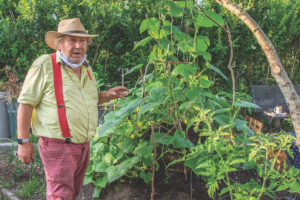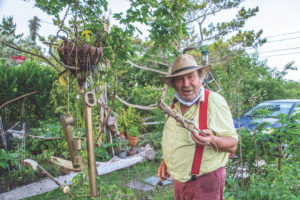TRURO — On a sunny hill overlooking Cold Storage Beach in North Truro, Gunter Hanelt, a jeweler by profession, tends to more organic treasures.

His overflowing vegetable garden boasts sugar-snap peas, tomatoes, collard greens, cantaloupes, multiple kinds of cucumbers, carrots, potatoes, herbs, and half a dozen mystery Macedonian seedlings, among other plants. Sprawled on the land where the historic Bayside House once stood, Hanelt’s garden looks like it’s been rooted there for years.
In reality, it’s only a few months old.
“When this Covid thing hit, I just got busy in the garden,” says Hanelt. “This garden is brand new: cleared in May and planted in June.” Hanelt’s garden encompasses multiple raised plots and two small hills, known as Hügel mounds, covered in sprouting plants.
While his garden is young, the technique that got Hanelt’s attention is not.
Hügelkultur is a horticultural practice used in Germany and Eastern Europe for centuries. It translates roughly as mound-gardening, and it involves creating — and planting directly into –– a pile of organic debris.
“I first dug a hole, about four feet deep by three and a half feet wide,” explains Hanelt. “Then I took all this organic material, like logs of Russian oak and beach-plum wood, and put it vertically into the hole. I piled a wheelbarrow of kitchen compost on top, with some salt hay, and then I put the rest of the sand from the hole over that with about a yard and a half of nice compost.”

The idea behind the Hügel, says Hanelt, is that the deep covering helps the buried wood decompose, and as it does, it slowly releases nourishment and develops a sponge-like consistency that holds a lot of water. “It’s alive down there,” he says.
According to the Permaculture Research Institute in Australia, the method makes sense because it mimics what you might find in a completely natural environment. Not everyone is convinced of the science of Hügelkulture, though. An undated report by the Washington State University Extension Service provides instructions, but notes there are no peer-reviewed studies on Hügelkulture’s effectiveness.
What is widely agreed on is that these garden-hills work well in small spaces. They are three-dimensional, explains Hanelt, “and because you’re going vertical, you can plant almost triple the amount.”
The mound gardens are also a simple way to deal with the debris and wood that build up around gardens, according to Hanelt. Instead of burning it or paying someone to remove it, you bury the debris and then have a no-till garden, he explains.
That philosophy might also be why the Hügel mounds look so at home around Hanelt’s garden: none of the decorations and ornaments that pull the garden together were purchased.
“Everything here is found, or I had it already,” says Hanelt. A massive curved whale’s rib given to him by a friend is nestled among tall reeds he collected from East Harbor. Wind chimes made from brass pipes he found in the metal pile at the dump fill the air with a low hum long after they’ve collided.
Hanelt believes if something is meant to be in his garden, it will find its way to him: “The universe provides. Without you having to do anything, it comes to you.” The many lattices and metal frameworks that the tomato stalks have enveloped were also collected, one way or another. “It’s not recycling,” says Hanelt. “It’s upcycling.”
The benefits of Hanelt’s garden extend into the kitchen he shares with his wife, Maggie Hanelt, the youth services librarian at the Truro Public Library.
While Maggie makes the coffee, Gunter starts every day with a trip to the garden “to see everything,” and to pick the five or six collard leaves that form the basis of breakfast. Which is better, he believes, with bacon, “half a slice for Maggie, one and a half for me.”
Gunter’s Morning Omelet
for two
This omelet can be made without bacon, substituting olive oil for sauteeing the vegetables.
5 or 6 large collard greens
1/2 sweet onion or a few scallions
About 6 mushrooms
2 slices bacon
Salt, pepper, turmeric
Cook the bacon in a skillet while prepping the collards: rinse them and separate the leaves from their stems, chop the stems into half-inch pieces, and shred the leaves.
When the bacon is crisp, remove it and set it aside, crumbling it into a little pile on each plate.
In the fat in the pan (or in olive oil if you’re not eating bacon), fry up the onion, mushrooms, and collard stems. Season them with fresh-ground pepper, salt, and turmeric, “which turns the whole thing a nice yellow color.”
When those vegetables are tender, add the shredded collard leaves to the pan and cover for a minute or so to wilt them.
Lightly scramble two eggs and pour them over the top of the vegetables in the skillet. When the bottom of the eggs is setting up, but the top is still runny, cut the omelet into quarters and turn them over to cook the other side lightly.
Serve the omelet slices over the bacon, to warm it up.
